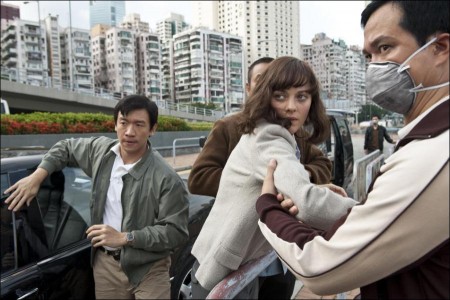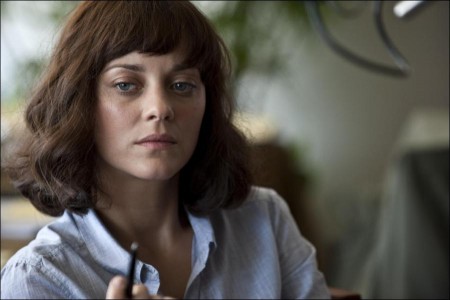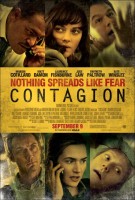Taglines: Nothing spreads like fear.
Contagion follows the rapid progress of a lethal airborne virus that kills within days. As the fast-moving epidemic grows, the worldwide medical community races to find a cure and control the panic that spreads faster than the virus itself. At the same time, ordinary people struggle to survive in a society coming apart.
Contagion is directed by Steven Soderbergh and written by Scott Z. Burns. The project was announced in February 2010 with the news that Matt Damon and Jude Law were cast in Contagion in their first collaboration since The Talented Mr. Ripley in 1999. Kate Winslet and Marion Cotillard joined the cast later in the month. Sodebergh received cooperation from the Centers for Disease Control and Prevention and also worked with a group of scientific advisers for the film.
With a production budget of $60 million, filming began on September 25, 2010 and was initially scheduled to last until January 11, 2011. Filming locations included Atlanta, Chicago, Minneapolis, Dubai, Japan, Switzerland, the United Kingdom, Brazil, Russia, and Malaysia. In Hong Kong, filming took place at the Hong Kong International Airport. By February of 2011, Contagion was being filmed in San Francisco at the Bill Graham Civic Auditorium and other locations.
Production Information
Don’t talk to anyone. Don’t touch anyone. Stay away from other people.
“I think it’s always compelling to watch people struggling with a real-world problem, especially one with a ticking clock, where the stakes couldn’t be any higher,” states director Seven Soderbergh, whose new film, “Contagion,” raises questions about what might happen—on a personal, national and global level—if an unknown and quickly replicating deadly disease was able to spread unchecked. How would it start? How would it move? And how would we deal with it?
The inspiration for “Contagion” was sparked by a conversation, he believes, “anyone can relate to.” While working together on their previous project, “The Informant!,” Soderbergh and screenwriter Scott Z. Burns did a fair amount of traveling. Burns recalls, “Steven and I spent a lot of time on planes, and we talked about how often it seems people get sick when they travel. So the idea began as an exploration of the vulnerability of human beings in public places. I think all of us, when we come down with something, tend to think back over the past few days and who we spoke to, sat next to, or touched. It’s human nature.”
Sharing airspace with a contagious passenger or handling objects that harbor bacteria and then unconsciously rubbing our eyes can result in an annoying cold, but, the two began to speculate, what if these common, innocent interactions were circulating something much worse? And what if it rapidly expanded to worldwide proportions? People could be dead before they knew what hit them. Even more insidious, in the hours between contact and the onset of symptoms, it would be impossible to tell who had it… or who would get it next.
Matt Damon, who stars as one of the film’s central characters, marks his latest of multiple creative collaborations with Soderbergh on “Contagion” and says, “Steven’s movies don’t leave any fat on the bone. They’re lean and fast. For a subject like this, that pace mirrors the progression of the infection itself and how things spiral very quickly out of control, so you want that sense of acceleration. He knows exactly how to keep multiple threads alive and cut back to each one at the right time. The story really moves.”
“It’s not often you get the opportunity to make a movie that touches on themes that resonate with everyone, and can also be an entertaining thriller,” says Soderbergh. “When Scott and I talked about doing a serious film about a pandemic, I thought that because of what’s been happening in the world, plus all the advances in medicine and technology, we had to approach it in an ultra-realistic manner.” He admits, “Having been through the research now, I will never again think the same way about how we interact with one another. You cannot immerse yourself in this world and not be forever altered by your awareness of it.”
That awareness, one of the film’s themes, is amplified as the virus spreads. What makes “Contagion” so frightening on both an intellectual and a visceral level is that, while fictional, it is grounded in real science and real possibilities—and seen through the drama of individual lives and relationships that could soon be lost or forever changed. “It’s important that these characters feel like real people and not just medical experts or professionals in their field,” says Kate Winslet, who stars as a doctor working in one of the disease’s first identified hot-spots. “You’re accessing the world of this epidemic through human channels.”
Amid recent warnings of antibiotic-resistant superbugs and the ever-present concern over potential weaponization of biological agents, “we didn’t have to make anything up that wasn’t true, in a sense, to make it a more terrifying ride,” says Gregory Jacobs, Soderbergh’s longtime producing partner. “I love a good zombie movie, but we know that’s not real. The impact here comes from dealing with a horror set in our own backyards that manifests, at first, like the common cold. People look normal, they’re functional, so they move around and spread it without being aware. No one realizes there’s cause for concern until they’re critical. And by then it’s too late.”
Producers Michael Shamberg and Stacey Sher were equally intrigued by how the story taps into our most primal fears and survival instincts. “It shows not only how a virus could infiltrate the population in staggering numbers but how that could affect day-to- day life, when the familiar suddenly becomes unfamiliar and you’re afraid to go back into your own house or see your friends,” Shamberg observes.
Experts assign a tipping point to such scenarios: measured in days, it’s the point at which society begins to break down. Stores run out of food; banks, schools and gas stations close; borders are locked down. And though a crisis can inspire touching acts of compassion, the reality is more often panic, paranoia, and a lawlessness that quickly becomes a threat in itself.
“I think it’s going to be shocking and dramatic and a little upsetting,” says Jude Law of the film’s potential effect on audiences. “Also relevant in ways you don’t necessarily think about every day. Not touching door handles, and coughing into your hand as opposed to your elbow….suddenly all these little things start fizzing at the forefront of your consciousness.”
Says Sher, “Steven always asks ‘What’s real here, what would actually happen and what would they be saying?,’ because what’s real is often more chilling and smarter than anything you can make up.” With that in mind, the filmmakers drew upon information they received from the Centers for Disease Control and Prevention (CDC) and other infectious disease experts who served as technical advisors on the project— and which ultimately led her to conclude, “I think the question raised by ‘Contagion’ is not whether or not this could happen. It’s more a case of when.”
Burns agrees, citing, “The 1918 Spanish Flu wiped out 50 million people, one-fifth of the world’s population at the time and more than the total killed in World War I. Diseases spread exponentially. It just takes 30 steps to jump from one to one billion. Factoring in the incubation period, we could reach that number in 120 days.” Burns also learned that a new virus is discovered nearly every week. “That’s 52 fresh bullets loaded into a gun and aimed at the human race every year,” he says.
“Everything that happens in this movie could happen, or is already happening, which is the truly scary part,” adds Ricky Strauss, an executive producer on the film and president of Participant Media, the company created by Jeff Skoll to back movies that illuminate important social issues. After working with Soderbergh and Burns on “The Informant!,” Participant came aboard to support the development of “Contagion” and put at the filmmakers’ disposal their relationships with scientists at the Skoll Global Threats Fund, who are working on pandemic research.
But science and statistics tell only part of the story. Striving to paint a picture he calls “epic in scale and ambition but also intimate,” Soderbergh tracks the pandemic’s progress from several deeply personal points of view, along lines that run concurrently and influence one another but don’t necessarily intersect. In this way, “Contagion” reveals not only acts of bravery and sacrifice from average people and the professionals committed to protecting them, but the sometimes flawed and emotionally driven choices that make them who they are. In the process, he notes, “Each character confronts some aspect of his life that would have remained unexpressed or unchallenged if this disease hadn’t shown up.”
At the heart of the story is Damon’s character, Mitch Emhoff, a family man who sees a homecoming turn into a nightmare when his wife Beth, played by Gwyneth Paltrow, returns from a business trip and becomes the first known fatality of a mystery illness—so suddenly that he has no time to say goodbye.
When Beth’s autopsy stuns the local pathologist, he alerts the CDC. There, the hunt begins for answers, as researchers compare her symptoms with other recent deaths, analyze samples, and try to determine the extent of the threat even as it continues to evolve. Meanwhile, CDC Deputy Director Dr. Ellis Cheever, portrayed by Laurence Fishburne, weighs the consequences of full disclosure against a wait-and-see approach that might save more lives in the long run.
Under Cheever’s direction, Dr. Erin Mears, played by Kate Winslet, eagerly accepts her first prestigious assignment as a CDC Epidemic Intelligence Service (EIS) officer, alongside first responders in the field. But the parameters of the job—and its risks—prove far beyond what either of them expected. Simultaneously, at the World Health Organization (WHO) in Geneva, clusters of new cases light up sectors on a world map as epidemiologist Leonora Orantes, played by Marion Cotillard, works urgently to reconstruct the final days of Beth’s itinerary and connect the seemingly random dots that lead back to ground zero. And patient zero.
As the virus rapidly advances—invisible, relentless and indiscriminate—a different kind of contagion appears, introduced by outsider journalist Alan Krumwiede, played by Jude Law as a man convinced the government is withholding the truth and maybe even a possible cure. Although many of the issues Krumwiede raises are valid, his methods fan the grassfire of alarm and, says Jacobs, “contribute to the film’s atmosphere of shifting tones and levels, at once a drama, a mystery and a thriller.”
“Part of the story is the way in which information spreads along similar pathways to that of a virus: who gets it and how it moves forward, how it’s altered as it moves from one host to another or one organization to the next. And Krumwiede is the face of that idea,” says Soderbergh. “That was our focus throughout the movie, treating information like a baton that gets passed from one scene to the next. There are so many interesting tributaries. In this situation, it’s a lethal problem because misinformation can kill.”
The First Patient Is Identified
Mitch Emhoff: We need an ambulance. My wife…
“Steven sent me the script with a note that said, ‘Read this and then go wash your hands,’” says Matt Damon, with a laugh. “After seeing this movie in a theater filled with strangers, I’m sure that thought will definitely cross peoples’ minds.”
The actor describes his character, Mitch Emhoff, as “an everyman, one of the human faces of the epidemic. In very short order he loses his wife and stepson to this supervirus, leaving him with only one surviving family member, his 15-year-old daughter, Jory. For him, it then becomes all about keeping her safe.”
Soderbergh explains, “Mitch isn’t from the medical or scientific world and so doesn’t know what’s happening, and in that respect he represents most of us. The challenge was to keep his situation dynamic so that he isn’t simply being acted upon, and Matt was a great collaborator. He understood what we were trying to accomplish in each moment. You never catch him acting. There’s no vanity, no self-consciousness in his performance; it’s as if the cameras aren’t there.”
“Mitch is the audience’s proxy and their way into the story,” says Sher. “Watching him do things that, days earlier, he didn’t think possible, makes you wonder what you would do to protect your family and survive, and if you could do it with the same degree of grace and courage.”
The movie’s themes of fear and unpredictability hit home in the relationship between Emhoff and his daughter, played by Anna Jacoby-Heron in her feature film debut. Damon says, “It was very easy for me to relate, being a dad myself. Even though they’re going through this extraordinary experience, they’re still dealing with typical issues of parents and teenagers. She wants to see her boyfriend, and Mitch keeps trying to impress upon her the severity of the situation and why even the slightest contact with him, if he’s infected, could kill her. It leads to some highly charged moments.”
Mitch is also left to deal with emerging truths about his wife. Gwyneth Paltrow stars in the role that reunites her onscreen with Damon for the first time since “The Talented Mr. Ripley.” She says, “Beth Emhoff is a working mom who audiences meet as she’s wrapping up a business trip to Hong Kong and on her way home. She’s already sick, but it doesn’t seem serious enough yet to worry her.”
Though Beth succumbs early, she remains a vital thread running through the movie as research teams at home and abroad work to pinpoint her part in the epidemic. Says Soderbergh, “Beth’s story is revealed gradually. She’s the center of the detective aspect of the movie, the mystery of how it all started, and audiences learn more about her character as the action progresses.”
Ultimately, a series of snapshots Beth takes while visiting Asia helps to retrace her steps and uncover the source of her infection. Soderbergh suggested that Paltrow take those photos herself, while on location. A first-time visitor to the city, she says, “I was just another tourist in Hong Kong, taking pictures. At the same time, I did feel a little pressure. When Steven Soderbergh gives you a photo assignment, you had better come back with something decent.”
Paltrow acknowledges her character could be considered lucky, in a way, to be among the burgeoning plague’s first casualties, because it’s the survivors who face the thorniest challenges: “You start to wonder what you would do in that scenario, and where you’d go for clean water and food. You ask yourself how prepared you would be for a crisis of this scale. We rely so heavily on the infrastructure of society, I think the answer is that we’d all be in quite a lot of trouble.”
The Response
Cheever: So we have a virus, no treatment protocol and no vaccine.
Representing a cornerstone of that infrastructure is CDC Deputy Director Ellis Cheever, leading the effort to protect, inform and set public policy in the U.S. amid the fast-moving crisis. Cast as Cheever, Laurence Fishburne says, “He’s a smart, competent guy, the voice of reason. He’s the one people look to for reassurance that everything is under control, that we have the best people working on the problem and it’s going to be fine.”
“Laurence is immensely credible as an authority figure, so commanding,” Soderbergh declares.
Cheever works closely with his boss, Lyle Haggerty, but though they’re both physicians and friends, and united toward a common goal, they don’t always see eye-toeye. Haggerty’s military background affects the concerns uppermost on his mind, bringing another nuance to the situation. Bryan Cranston, starring as Haggerty, says, “There are highly sensitive issues here, with global implications. You have to be very careful with the dissemination of information and its ripple effect toward countries around the world. Everything has to be very specific and triple-checked.”
Under their aegis, researchers work around the clock to isolate, analyze and try to produce a vaccine for the deadly pathogen that’s always a few steps ahead. Chief among them, in both drive and expertise, is the maverick Dr. Ally Hextall, portrayed by Jennifer Ehle, who describes the facility’s high-security labs as “the place to go when you have no idea how a virus is transmitted from one person to another, you have no idea where it comes from, how it travels, how it grows, or how to stop it.”
While Hextall and her team race to find the answers to these questions, Cheever addresses the media from the eye of this hurricane. Under pressure from all quarters and with no solid news to impart, he must constantly decide what to say versus strategically holding back details that could do more harm than good.
Cheever has been following protocol for years, never revealing confidential intel outside the bounds of his office. But when he becomes privy to information that could mean life or death for the woman he loves, Aubrey, he faces a deeply personal and potentially damning choice: does he tell her—and her, alone—what he knows before it’s public knowledge? Aubrey, portrayed by Sanaa Lathan, is the world to him. Surely he can trust her not to tell anyone else. But, screenwriter Burns concedes, “In the same way a virus cannot be contained, it’s very hard to keep a secret.”
“This dilemma really is the measure of his character,” says Fishburne. “In his official capacity, he has a responsibility to protect the public and he takes that very seriously. But as a man, he has an obligation to his family. So he’s conflicted and has to make a tough choice.”
“We made that Cheever’s Achilles’ heel because it’s everyone’s Achilles’ heel,” states Soderbergh. “In the same situation, would I tell my daughter?”
Cheever is further torn about having handpicked Dr. Erin Mears as the Epidemic Intelligence Service officer to lead the charge among first responders in the field. By granting her the assignment she earnestly wanted and deserved, he may have unwittingly sealed her fate.
Cast as Mears, Kate Winslet feels it would not have deterred the novice officer one iota had she known the true risk at the outset. Researching the role, Winslet spent time at the CDC and met with past and present EIS officers who offered her a real sense of not only the job but also the kind of person who fills it. “I was told by some that they feel most alive when they’re on a mission,” she relates. “You have to be incredibly determined to do this work. It means sacrificing a lot of sleep, a social life, and your own safety, but it’s an honor to be chosen. It’s what they all train for and want to do. These are people who can be sent into war zones where there’s been an outbreak of a new virus. Fear is not an option. If they feel it, they learn to push it aside.”
“Mears serves as another gateway for the audience,” says Soderbergh. “It’s part of her job to explain the macro and micro of the situation simply and accurately, right down to the ways in which social distancing can prevent the infection spreading. But she’s confronting people in panic mode who are not always rational.”
Most importantly, “She brings it down to the layman’s level so we understand the impact without being bogged down by the science,” Winslet adds.
Starring as Mears’ counterpart in Geneva is Marion Cotillard as Dr. Leonora Orantes. As clusters of illness appear in London, Hong Kong, Tokyo and other cities around the world, simultaneously with cases in the U.S., Orantes begins to trace the sequence of transmission. “While everything else in the movie is hurtling forward, Orantes is effectively working backwards in time to unravel the mystery of where this thing came from, which is the key to figuring out where it might strike next,” says Shamberg.
Says Cotillard,” She starts with Beth Emhoff. Beth was the first person known to have died from the virus so Dr. Orantes tracks her itinerary. Fortunately for her, we now have video cameras everywhere so the first thing she does is study the footage from the cameras in the hotel, the elevator and the casino.” But even that can only take her so far. “You can discover a point of contact between two people, and you know both of them became ill, but it could have gone either way—the question is, which one of them infected the other?
“Meanwhile,” she adds, “Time is the enemy. As quickly as Orantes and the others work, the virus is moving even faster. People are dying and desperation is growing. When there is no more water and you need to drink, you will fight for water.”
Additionally, Orantes must always be aware of how events and investigations, and their potential consequences, might play out diplomatically on the world stage. “She gets dropped into situations and has to deal with cultural as well as scientific issues that are sometimes at odds,” says Soderbergh.
Perhaps because of that, he further explains, “Orantes is a somewhat locked-in character, very professional but also remote and dispassionate. But something happens to her in the course of the story that causes a significant emotional shift… something that would not have happened if not for her pursuing the origins of this virus.”
Joining the principal cast in Orantes’ sphere of the investigation are veteran German actor Armin Rohde as Orantes’ supervisor, Damian Leopold; and Chin Han (“The Dark Knight”) as Sun Feng, her official liaison to Hong Kong and Macau. John Hawkes (“Winter’s Bone”) also appears as Roger, a maintenance worker at the CDC who is concerned about the health of his young son.
The Epidemic of Fear
Krumwiede: First there were two people, then four, then 16. In three months it’s a billion. That’s where we’re headed. The truth is being kept from the world.
While the international medical community searches for a cure, confrontational freelance journalist Alan Krumwiede pursues an agenda of his own. Combining a genuine reporter’s instinct with a pathological distrust of all things official and a flair for the dramatic, he commits his popular blog to exposing the truth about the growing epidemic…as he sees it.
“His demand for the truth could be seen as heroic,” says Jude Law, starring as the man who claims—among other things—that there are more deaths than are being reported, and possibly an alternative cure being suppressed. “He believes people have a right to know and that information should be shared, especially when it’s something on this scale, and he was the first to break the story of a man dying on a Tokyo bus, who turned out to be one of the virus’ first victims. He has the courage of his convictions but his pride and ego often get in the way. He casts too broad a net for his stories and doesn’t always care about the repercussions of what he puts out there.”
“Krumwiede is not always wrong,” Soderbergh points out. But neither is he always right. And what he broadcasts takes on a life of its own as people desperate for answers turn to his blog. As the disease continues to proliferate, so does his subscriber base, from modest beginnings to 2 million, then 12 million people. “There are always conspiracy theories that percolate around significant events,” says Burns. “And just as a virus begins with one person and spreads, Krumwiede becomes the ‘index patient’ for what becomes a parallel epidemic of fear and panic.”
In developing the complex and undeniably charismatic character, Soderbergh recounts, “Jude and I talked about bloggers who take an anti-government, conspiracy theory approach—what they sound like, what they look like, and how they behave. We definitely wanted him to have a messianic streak.”
“What’s interesting is that you’re not really sure about him,” says Jacobs. “Is the government really hiding something and does the herbal remedy he’s talking about really work? I think we all suspect at one time or another that we’re not getting the whole truth, and in that sense Krumwiede represents the audience’s point of view.” “But,” Law confirms, “ultimately, he crosses the line.”
Representing one of Krumwiede’s prime targets is Elliott Gould, re-teaming with Soderbergh and his three-time “Ocean’s” co-star Matt Damon, as Dr. Ian Sussman, a San Francisco-based medical researcher working independently on a possible vaccine—against CDC orders. Monique Gabriela Curnen (“The Dark Knight”) also appears as a newspaper editor, Lorraine Vasquez, who dismisses Krumwiede’s bid for an exclusive just before the contagion breaks.
Contagion
Directed by: Steven Soderbergh
Starring: Matt Damon, Kate Winslet, Jude Law, Marion Cotillard, Gwyneth Paltrow, Laurence Fishburne, Jennifer Ehle, Anna Jacoby-Heron, Josie Ho, Sanaa Lathan
Screenplay by: Scott Z. Burns
Production Design by: Howard Cummings
Cinematography by: Steven Soderbergh
Film Editing by: Stephen Mirrione
Costume Design by: Louise Frogley
Set Decoration by: Cindy Carr
Art Direction by: Abdellah Baadil, Simon Dobbin, David Lazan
Music by: Cliff Martinez
MPAA Rating: PG-13 for disturbing content and some language.
Studio: Warner Bros. Pictures
Release Date: September 9, 2011
Hits: 173






